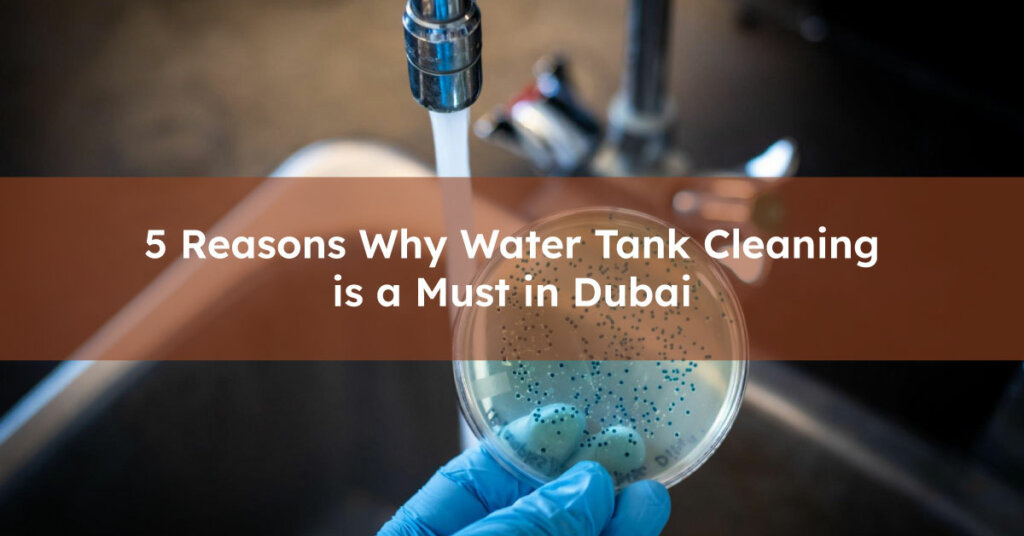When it comes to ensuring clean and safe water for your household or business, water tank cleaning is an essential task that should never be underestimated.
In Dubai, where water scarcity is a significant concern, maintaining the hygiene and integrity of your water storage systems is paramount.

Did you know that neglecting water tank cleaning in Dubai can lead to various health risks and even legal issues? In this article, we will explore five compelling reasons why water tank cleaning is a must in Dubai, shedding light on the importance and benefits of maintaining clean and uncontaminated water supplies.
Table of Contents
Key Takeaways
- Regular water tank cleaning ensures the quality and purity of the stored water.
- Complying with local regulations and guidelines is crucial for maintaining water tank hygiene in Dubai.
- Proper tank cleaning helps prevent waterborne diseases and protects the health of individuals.
- Regular maintenance, including tank cleaning, can extend the lifespan of water systems.
- Clean water tanks improve the taste and odor of water, meeting the expectations of customers, especially in the hospitality industry.
Reason 1: Ensuring Water Quality
Regular water tank cleaning is crucial for ensuring clean water storage in Dubai. Over time, sediment, debris, and microorganisms can accumulate in the water tanks, leading to contamination. These contaminants can affect the taste, smell, and overall quality of the water.
Cleaning your water tanks regularly eliminates these contaminants and ensures that the water stored in your tanks remains clean, pure, and suitable for consumption. By maintaining water quality, you can protect the health and well-being of your family or customers.
Reason 2: Compliance with Local Regulations
Another significant reason to prioritize water tank cleaning in Dubai is to comply with local regulations. The Dubai Municipality has guidelines in place to ensure the hygiene and safety of water storage systems. These guidelines outline the frequency, methods, and standards for tank cleaning. By hiring professional water tank cleaning services, you can ensure that your tanks meet these regulations and avoid any penalties or legal issues. This applies to both residential and commercial properties.
Dubai Municipality Guidelines
Complying with the Dubai Municipality guidelines for water tank cleaning is essential to maintain the health and safety standards of your water storage systems. These guidelines are designed to prevent the spread of waterborne diseases and ensure the delivery of clean and uncontaminated water to households and businesses in Dubai.
Residential and commercial property owners must adhere to the following guidelines:
- Frequency: Regular cleaning should be conducted according to the recommended schedule. This ensures that the tanks are free from any harmful contaminants and pathogens that may compromise water quality.
- Methods: The Dubai Municipality guidelines specify the approved methods for water tank cleaning. This includes the use of specialized equipment, safe cleaning agents, and proper disinfection techniques.
- Standards: The guidelines outline the standards that need to be met during the cleaning process. These standards aim to maintain the water quality, prevent cross-contamination, and ensure the overall cleanliness of the tank and its surroundings.
By following these guidelines and hiring professional water tank cleaning companies, you can be confident that your tanks are regularly maintained, compliant with the regulations, and providing safe, clean water for your property.
| Benefits of Complying with Dubai Municipality Guidelines |
|---|
| 1. Ensures the health and safety of your family or customers by providing clean and uncontaminated water. |
| 2. Avoids penalties and legal issues by meeting the requirements set by the Dubai Municipality for water tank hygiene. |
| 3. Prevents the spread of waterborne diseases by eliminating harmful contaminants and pathogens from the tanks. |
| 4. Preserves the lifespan of your water storage system by maintaining its cleanliness and preventing corrosion and damage. |
| 5. Improves the taste and odor of the water, ensuring a pleasant and refreshing experience for consumers. |
Reason 3: Preventing Waterborne Diseases
Regular water tank cleaning is crucial for preventing waterborne diseases. If the tanks are not cleaned regularly, harmful bacteria, viruses, and other pathogens can multiply and contaminate the water. Drinking or using this contaminated water can lead to various illnesses and health problems. By scheduling periodic tank cleanings, you can significantly reduce the risk of waterborne diseases and protect the health of your family or customers.
Reason 4: Extending Lifespan of Water Systems
Adequate water tank maintenance, including regular cleaning, can help prolong the lifespan of your water systems. When tanks are not cleaned regularly, the accumulation of sediment and debris can cause corrosion and damage to the tank and its components. This can lead to leaks, reduced water pressure, and costly repairs.
By investing in water tank cleaning and maintenance, you can preserve the integrity of your water storage system, minimize the need for repairs, and maximize its lifespan. Regular maintenance not only ensures the longevity of your water tanks but also helps in maintaining the efficiency and performance of the entire water system.
With proper cleaning and maintenance, you can prevent the buildup of harmful substances that can corrode the tank and its internal mechanisms. By removing sediment, rust, and other contaminants, you can prevent premature degradation and extend the lifespan of your water systems.
| Benefits of Water Tank Maintenance | |
|---|---|
| 1. Prolongs the lifespan of water systems | |
| 2. Prevents corrosion and damage | |
| 3. Reduces the risk of leaks and water pressure issues | |
| 4. Minimizes repair costs | |
| 5. Maintains the efficiency and performance of the water system |
By prioritizing water tank maintenance, you not only save time and money but also ensure a reliable water supply for your household or business. Whether you have a residential or commercial property, regular cleaning and maintenance are essential to keep your water systems functioning optimally for years to come.
Reason 5: Improving Taste and Odor of Water
Regular water tank cleaning is not only essential for hygiene but also for enhancing the taste and odor of the water stored in Dubai. Over time, sediment, minerals, and other impurities can accumulate in the tanks, causing the water to develop an unpleasant taste and odor. This can be particularly noticeable in the hospitality industry, where customers expect clean and fresh-tasting water for their drinking and cooking needs.
By prioritizing regular tank cleaning, you can effectively remove these contaminants and ensure that the water in your tanks is pure and refreshing. This improvement in taste and odor not only enhances the overall drinking experience but also promotes customer satisfaction and loyalty.
For businesses in Dubai, providing clean and fresh water is crucial in maintaining a positive reputation and attracting customers. Whether you run a hotel, restaurant, or cafe, investing in professional water tank cleaning services can help you deliver the highest quality water to your customers, ensuring that their expectations are met and surpassed.
Conclusion
Water tank cleaning in Dubai is crucial. It ensures clean, safe drinking water and keeps us healthy. This practice avoids legal trouble by following Dubai’s strict guidelines. Plus, it stops diseases from spreading. Regular cleaning also means water systems last longer and work better. And let’s not forget, it makes water taste and smell good. This is especially important for businesses that want to impress customers.
In short, cleaning water tanks is a must-do in Dubai. It’s good for our health, it’s the law, and it saves money in the long run. It also ensures that water is pleasant to use. So, whether you’re a homeowner or a business, make sure to keep your water tanks clean. It’s a small step with big benefits.




